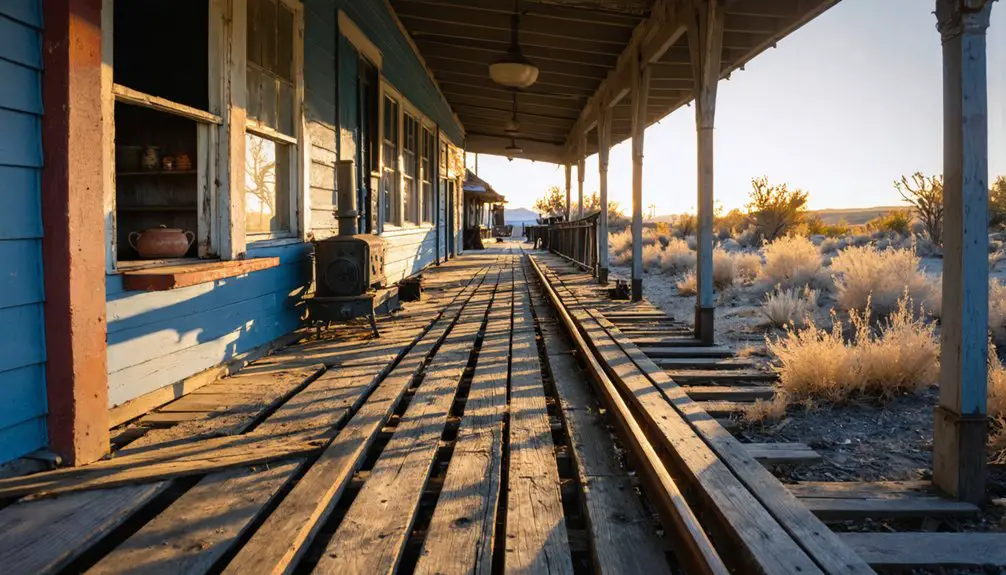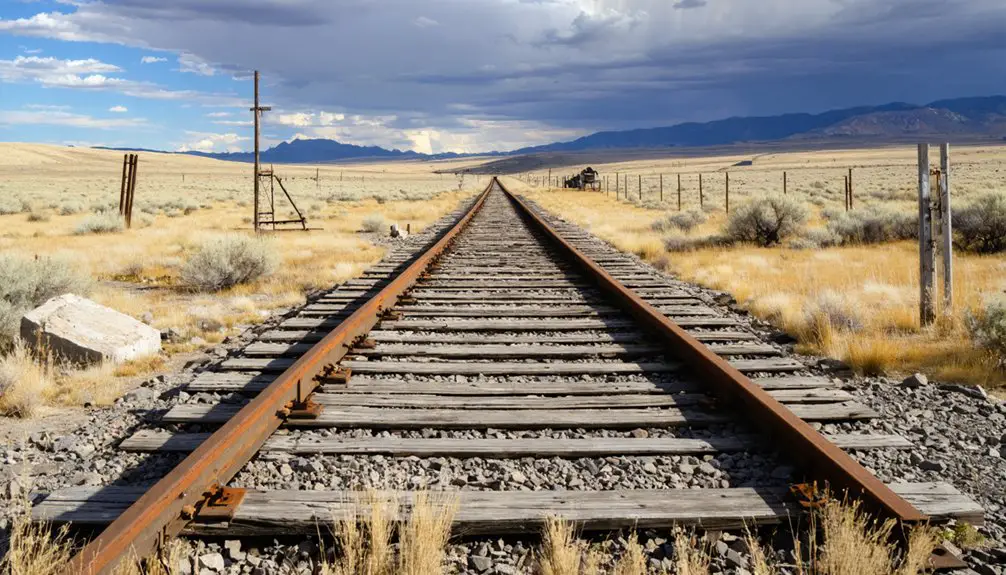You’ll find Sherman’s ghost town remains at 8,247 feet in Wyoming’s Laramie Mountains, where it once served as Union Pacific Railroad‘s highest point on the transcontinental line. In the 1870s, this crucial hub housed hundreds of residents, featuring a roundhouse, hotels, and saloons despite brutal mountain conditions. Though abandoned in 1918, you can still visit the historic Ames Monument and Sherman Cemetery, where countless stories of frontier railroad life await exploration.
Key Takeaways
- Sherman was established in 1868 as a vital Union Pacific Railroad outpost at 8,247 feet, the highest point of the transcontinental railroad.
- The town supported hundreds of residents with hotels, saloons, stores, and railroad facilities including a five-stall roundhouse and turntable.
- Extreme weather conditions, including hurricane-force winds and brutal winters, characterized daily life in this mountain settlement.
- Railroad operations dominated town activities, with crews managing train inspections, track maintenance, and water supply for steam engines.
- The town was abandoned in 1918 after railroad realignment, leaving only Sherman Cemetery and the Ames Monument as historical landmarks.
Birth of a Mountain Railroad Town
When the Union Pacific Railroad sought the perfect location for a critical service stop along its transcontinental route in the 1860s, they chose a windswept summit 8,247 feet above sea level in Wyoming’s Laramie Mountains.
Originally known as Lone Tree Pass and Evans Pass, the site was renamed Sherman at the request of Civil War General William Tecumseh Sherman himself. Due to its historical significance, Sherman required careful link disambiguation to distinguish it from other locations sharing the name.
General Sherman, the legendary Civil War commander, personally requested the renaming of this historic mountain pass in his honor.
As railroad expansion transformed the American West, this strategic location quickly grew into a bustling mountain community. Located 19 miles southeast of Laramie, Sherman became a vital transportation hub.
You’d have found a complete railroad town, with a five-stall roundhouse, turntable, and massive windmill pumping 50,000 gallons of water for steam engines.
The town’s community dynamics centered around two hotels, two saloons, a general store, post office, and schoolhouse – all serving the hundreds of residents who called this mountain summit home.
Life at 8,000 Feet: Sherman’s Peak Years
If you’d visited Sherman during its peak years in the 1870s, you’d have found a bustling railroad town where Union Pacific crews worked around the clock maintaining trains and tracks at 8,247 feet.
Living at this elevation meant adapting to year-round cool temperatures and short growing seasons, forcing residents to rely heavily on imported supplies and goods brought in by rail.
The town’s social life centered primarily around railroad operations, with workers and their families gathering at local establishments and community events, all while enduring the harsh mountain weather that defined life in this high-altitude settlement. Located just a quarter mile from the Ames Monument, Sherman served as a critical transportation hub for the region. The area’s dramatic landscape was dominated by Sherman Granite formations, towering features that had stood for over 1.4 billion years before the town’s establishment.
Daily Railroad Town Operations
Located at the highest point of the transcontinental railroad, Sherman’s daily operations revolved entirely around managing the challenges of train travel at 8,269 feet.
You’d find a bustling scene of railroad scheduling and freight management, with trains stopping for mandatory inspections before tackling the treacherous descent. The five-stall roundhouse and turntable kept locomotives maintained, while the windmill-powered water tank stood ready to service thirsty engines. The nearby quarries provided essential Sherman waste ballast for maintaining the track beds.
Train crews coordinated their movements through a sophisticated traffic control system, using Written Track Warrants and Automatic Block Signaling to guarantee safe passage. Sherman’s two hotels housed crews between runs, while the general store and saloons served both railroad workers and townspeople. Native American resistance through guerilla warfare tactics made constant vigilance necessary for safe operations.
Helper locomotives stood by, ready to assist heavy trains up the demanding 1.55% grade.
Living Through Harsh Weather
Living at Sherman’s 8,269-foot elevation demanded extraordinary resilience from its residents, who endured some of Wyoming Territory’s harshest weather conditions.
You’d face brutal winters with temperatures plunging below 15°F and wind chills dropping to 6°F, while hurricane-force gusts up to 47 mph tested your weather survival skills daily.
Your winter adaptations had to be swift and thorough. You’d layer clothing strategically, maintain constant fires, and stockpile provisions before storms hit.
Even in summer, residents dealt with intense winds gusting to 30 mph that made daily tasks challenging.
Living spaces required thick walls and sturdy construction to withstand heavy snow loads and piercing winds.
With a growing season too short for reliable farming, you’d depend on preserved foods, hardy vegetables, and hunting to sustain your family through the long, harsh winters.
Even today, the area experiences challenging conditions with light rain and limited visibility of 6 miles.
Community Social Activities
Despite Sherman’s harsh mountain environment, social life flourished around key gathering spots that formed the heart of this bustling railroad community.
You’d find locals and railroad workers mingling at the two saloons, sharing stories over drinks, or gathering at the hotels’ common rooms for evening entertainment. The Wells Fargo office provided another important meeting place for residents conducting business and exchanging news. The general store and post office served as daytime social hubs where you could catch up on news while picking up supplies.
- Card games and music filled the saloons with laughter and camaraderie
- Social gatherings at Sherman House and Summit House brought together travelers and residents
- Children’s voices echoed from the one-room schoolhouse during weekdays
- Recreational activities included outdoor pursuits like hunting in the surrounding mountains
These social connections helped residents weather the isolation of life at 8,000 feet, creating a tight-knit mountain community.
The Engineering Marvel of Dale Creek Bridge
When Union Pacific engineers tackled the intimidating Dale Creek gorge in 1868, they created one of the most remarkable railroad bridges in American history.
You’d marvel at this wooden trestle bridge stretching 650 feet across the gap and soaring 150 feet above a narrow creek.
The engineering challenges were immense. The original timber structure swayed dangerously in Wyoming’s fierce winds, forcing trains to crawl across at just 4 mph.
Some train engineers refused to operate locomotives across the precarious span.
By 1876, they’d replaced it with an iron “spider web” design, though even this sturdier version required extensive reinforcement with guy wires and granite abutments.
While the bridge showcased American ingenuity, its precarious nature eventually led Union Pacific to reroute the line south to Hermosa in 1901, leaving behind a monument to railroad pioneers’ determination.
Daily Life in a Frontier Railway Stop

If you’d lived in Sherman during its railroad heyday, you’d have witnessed railroad workers performing demanding tasks like servicing steam engines in the five-stall roundhouse and inspecting trains before their perilous mountain descents.
The harsh environment at 8,262 feet didn’t stop workers from finding entertainment after their shifts, as they frequented the town’s two saloons and lodged at either the Sherman House or Summit House hotels.
Beyond work hours, the small community of several hundred residents created their own diversions within the limited confines of their general store, post office, and schoolhouse, making the best of life at the world’s highest railroad summit.
Railroad Workers’ Daily Routines
As steam locomotives thundered through Sherman’s mountain pass, crews maintained a relentless schedule of inspection, maintenance, and operations at 8,247 feet above sea level.
You’d find railroad safety was paramount as workers battled harsh weather and treacherous terrain while servicing engines in the five-stall roundhouse. Strong worker camaraderie developed through shared challenges and long shifts dictated by train schedules.
- Engine crews inspect boilers and perform mechanical checks before tackling steep mountain grades.
- Track maintenance teams brave extreme conditions to repair rails and ties during off-peak hours.
- Roundhouse workers coordinate the constant flow of locomotives needing water and fuel.
- Signal operators maintain crucial communication links to guarantee safe passage through the summit.
The daily grind was demanding, but these frontier railroaders kept America’s first transcontinental line running smoothly through Sherman Pass.
Social Activities After Hours
Though Sherman’s days were dominated by railroad operations, its social life flourished in two bustling saloons, a pair of hotels, and the local general store.
You’d find yourself drawn to nighttime gatherings where railroad workers swapped tales over card games and drinks, while travelers passing through added fresh stories to the mix.
The Sherman House and Summit House hotels hosted social dances, giving you a chance to escape the harsh Wyoming landscape for an evening of entertainment.
At the general store, you’d catch up on local gossip and news while picking up supplies.
Even the schoolhouse transformed after hours, hosting community events that brought families together.
Saloon stories echoed through the evening, carrying tales of the day’s railway adventures and frontier life.
Notable Buildings and Landmarks
While Sherman’s buildings have largely vanished, several notable landmarks chronicle this historic railroad town’s legacy. The towering Ames Monument stands as the most prominent architectural remnant, marking the railroad’s highest elevation point at 8,247 feet.
Beyond this enduring pyramid, you’ll find scattered traces of Sherman’s historical significance across the windswept landscape.
- Two competing hotels – the Sherman House and Summit House – once offered weary travelers a place to rest.
- A solitary one-room schoolhouse served the town’s children.
- The bustling commercial district featured a general store, post office, and two lively saloons.
- Essential railroad facilities included a five-stall roundhouse, turntable, and water tank supported by a windmill.
Today, only foundations and archaeological artifacts remain to tell the story of this once-thriving railroad community.
The Role of Union Pacific Railroad

The Union Pacific Railroad transformed Sherman from empty wilderness into a bustling mountain outpost in 1868, establishing it as the highest point on their transcontinental route at 8,242 feet.
You’ll find that railroad expansion through this challenging terrain required extensive infrastructure, including a five-stall roundhouse, water tanks, and the revolutionary Dale Creek Bridge.
The town’s economic impact peaked as hundreds of residents supported essential railroad operations, with helper engines assisting trains over the steep grades.
However, Union Pacific’s strategic realignments spelled Sherman’s doom. First came the 1901 track shift between Buford and Hermosa, then the 1951 Harriman line that reduced operational demands.
Stories From Sherman Cemetery
Standing sentinel on a windswept hill near the Ames Monument, Sherman Cemetery offers a poignant glimpse into the lives and losses of this former railroad town’s inhabitants.
You’ll find forgotten lives etched into the landscape, with only one marked headstone remaining – that of young Lester C. Hegkert, who lived barely a year from 1882 to 1883.
- Scattered pottery shards and rusted tin cans whisper tales of ghostly encounters
- Unmarked depressions in the earth reveal where families once laid their loved ones to rest
- Wild Wyoming winds sweep across graves where railroad workers’ children sleep eternally
- Nature’s wildflowers now blanket the final resting place of Sherman’s hardy pioneers
Many families relocated their deceased when the town died in 1918, leaving behind this silent memorial to Wyoming’s railroad era.
The Town’s Final Days
Death came gradually to Sherman, much like the slow fading of its cemetery grounds.
Time slips away from ghost towns like grains of sand, leaving only whispers of what once was.
When Union Pacific moved its tracks three miles south in 1918, you’d have witnessed the town’s lifeblood slowly drain away. The railroad’s decision sealed Sherman’s fate, as the once-bustling station point became obsolete.
You’d have seen the town’s economic decline unfold as essential services vanished one by one. The roundhouse fell silent, the water tank dried up, and the hotels emptied.
Without the railroad’s steady stream of traffic, businesses couldn’t survive. Families packed up and left, taking their loved ones’ remains from the cemetery with them.
The harsh reality of Sherman’s 8,200-foot elevation and rocky terrain made any chance of reinvention impossible. Town abandonment was complete when the last residents departed, leaving only foundations and memories behind.
What Remains Today: A Historical Legacy
Today, Sherman’s weathered remains tell a compelling story of Wyoming’s railroad history. Through careful cultural preservation and historical interpretation, you’ll discover traces of this once-bustling railroad town high in the Laramie Mountains at 8,247 feet.
The majestic Ames Monument stands as the site’s crown jewel, recently restored and protected as a National Historic Landmark.
- Foundation ruins outline where the general store, hotels, and saloons once served weary travelers
- A small pioneer cemetery whispers tales of those who made Sherman their final home
- The preserved one-room schoolhouse reflects daily life in this frontier community
- Historic markers and interpretive signs guide you through the town’s railroad legacy
These remnants paint a vivid picture of life at what was once the highest point on the Union Pacific Railroad.
Frequently Asked Questions
Were There Any Famous Train Robberies or Outlaws in Sherman’s History?
Quick as lightning, you’ll find train heists were a hot ticket near Sherman, with notorious outlaws like Butch Cassidy’s Wild Bunch and Bill Carlisle stealing $50,000+ in daring robberies.
What Was the Average Winter Temperature and Snowfall in Sherman?
You’d have experienced harsh winter temperatures averaging 5-10°F in January, with dramatic 50°F swings possible. Your average snowfall would reach 138 inches annually, though chinook winds often brought unexpected thaws.
How Did Children in Sherman Travel to School During Harsh Weather?
Through thick and thin, you’d bundle up and walk to school with other children, sometimes using horse-drawn sleighs when available. Railroad workers occasionally helped transport kids during extreme weather challenges.
Did Native American Tribes Have Any Significant Interactions With Sherman Residents?
You’ll find that Native Americans maintained complex trade relationships with Sherman’s residents, though tensions existed. Cultural exchanges occurred through fur trading and sharing local knowledge about the surrounding landscape and resources.
What Happened to the Dale Creek Bridge After Sherman Was Abandoned?
Picture massive iron beams being dismantled piece by piece – that’s what happened to Dale Creek Bridge. You’d find its materials were repurposed throughout Union Pacific’s rail system after 1901’s route abandonment.
References
- https://kids.kiddle.co/Sherman
- https://en.wikipedia.org/wiki/Sherman
- https://wakeupwyo.com/vanishing-wyoming-the-railroad-town-of-sherman/
- http://www.apcrp.org/Roads Less Traveled/SHERMAN_WY/Sherman_Mast.htm
- http://userpages.aug.com/bdobson/sherman.html
- https://www.trains.com/trn/railroads/history/sherman-hill-the-first-rocky-mountain-railroad-pass/
- http://www.wyomingtalesandtrails.com/sherman4.html
- http://www.wyomingtalesandtrails.com/sherman.html
- https://www.geowyo.com/vedauwoo.html
- http://plantsandrocks.blogspot.com/2012/02/creatures-of-stone-iii-rest-of-story.html



